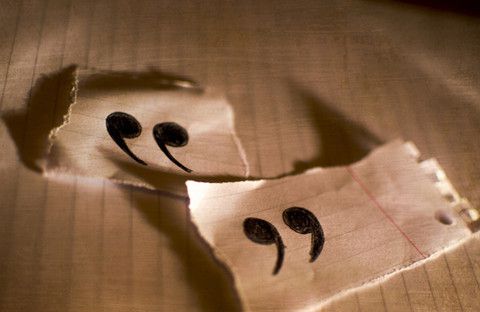小逗号大讲究,它的用法知多少?

逗号(comma)是英文书写中常用的标点符号,可以切分意群,表示停顿等等,下面就让我们来学习一下逗号的五种具体用法吧。
1.Using commas in lists 用在并列词语中
要用逗号隔开一系列并列的事物,让我们看看下面的例句:
(1)Saturday morning started with a hearty breakfast of scrambled eggs, bacon, sausage, and French toast.
周六的早晨始于一顿丰盛的早餐:炒蛋、培根、香肠、法式土司。
(2)The school has a vegetable garden in which the children grow cabbages, onions, potatoes, and carrots.
学校里有个菜园,孩子们在菜园里种上卷心菜、洋葱、土豆、胡萝卜。
(Tip:注意在中文写作中,并列的一系列事物常用顿号隔开,可不要混为一谈哦。如果要使用逗号,并列词语之间带有“啊”“呀”“啦”等语气助词,如:八月的大街上摆满了水果,像甜瓜啊,西瓜啊,苹果啊,葡萄啊……)
“and”前的逗号称为序列逗号,也叫牛津逗号,并非一定要使用,但是它可以使文章表意更清晰。请看下面的对比句:
My favourite sandwiches are chicken, bacon and ham and cheese.
My favourite sandwiches are chicken, bacon, and ham and cheese.
第一句话会使人产生歧义,不知道是作者最喜欢的三明治是鸡肉、培根、火堆、芝士这四种馅料制作的,还是喜欢鸡肉三明治、培根三明治、火腿芝士三明治这三类,而使用了序列逗号就使读者一目了然作者的意图是后者。
2. Using commas in direct speech 用在直接引语中
直接引用别人的原句称为直接引语。直接引语需要在前引号前用逗号来引导。让我们看看下面两个例句:
(1)Steve replied,"No problem."
史提夫回答道:“没问题。”
(Tip:注意此种情况在中文写作中要用引号来引导直接引语。)
(2)"Yes," he said, "and I always keep my promises."
“是的,”他说,“我总是信守承诺。”
但若引用内容为感叹句或疑问句则可不用逗号。如:
"Stop him!"she shouted.
"让他停下!"她喊道。
"Did you see that?" he asked.
“你看到了吗?”他问。
3. Using commas to separate clauses 用来划分主从句
用逗号划分主从句可以使句子结构更加清晰明白,让我们看看下面两个例句:
Having had lunch, we went back to work.
吃过午饭后,我们回去工作。
I first saw her in Paris, where I lived in the early nineties.
我第一次见她是在巴黎,九十年代初我住在那里。
在限制性定语从句中,如:Passengers who have young children may board the aircraft first. (带小孩的乘客可以先登机。)无须使用逗号。
4. Using commas to mark off parts of a sentence 用逗号插入成分
英文写作中常出现用两个逗号插入成分的情况,用于解释说明前文内容,或者表达作者态度等等。看下面例句:
Cynthia’s daughter, Sarah, is a midwife.
辛西娅的女儿萨拉是一位助产士。
Gunpowder is not, of course, a chemical compound.
火药当然不是化合物。
5. Using a comma with 'however' 用在“however”后
However有两种意思:
(1)当用作副词,表示“然而,可是”后面需要使用逗号,如:
This was not an easy decision. It is, however, a decision that we feel is dictated by our duty.
这很难抉择。可是,我们觉得自己有义务作出决定。
(2)当其用作连词,表示“不管怎样”则不能使用逗号,如:
However we adopt healthcare reform, it isn't going to save major amounts of money.
不管我们采取何种医疗改革措施,都省不下太多钱。